Zhenliang Zhang
JointCQ: Improving Factual Hallucination Detection with Joint Claim and Query Generation
Oct 22, 2025Abstract:Current large language models (LLMs) often suffer from hallucination issues, i,e, generating content that appears factual but is actually unreliable. A typical hallucination detection pipeline involves response decomposition (i.e., claim extraction), query generation, evidence collection (i.e., search or retrieval), and claim verification. However, existing methods exhibit limitations in the first two stages, such as context loss during claim extraction and low specificity in query generation, resulting in degraded performance across the hallucination detection pipeline. In this work, we introduce JointCQ https://github.com/pku0xff/JointCQ, a joint claim-and-query generation framework designed to construct an effective and efficient claim-query generator. Our framework leverages elaborately designed evaluation criteria to filter synthesized training data, and finetunes a language model for joint claim extraction and query generation, providing reliable and informative inputs for downstream search and verification. Experimental results demonstrate that our method outperforms previous methods on multiple open-domain QA hallucination detection benchmarks, advancing the goal of more trustworthy and transparent language model systems.
Exploring Causal Effect of Social Bias on Faithfulness Hallucinations in Large Language Models
Aug 11, 2025Abstract:Large language models (LLMs) have achieved remarkable success in various tasks, yet they remain vulnerable to faithfulness hallucinations, where the output does not align with the input. In this study, we investigate whether social bias contributes to these hallucinations, a causal relationship that has not been explored. A key challenge is controlling confounders within the context, which complicates the isolation of causality between bias states and hallucinations. To address this, we utilize the Structural Causal Model (SCM) to establish and validate the causality and design bias interventions to control confounders. In addition, we develop the Bias Intervention Dataset (BID), which includes various social biases, enabling precise measurement of causal effects. Experiments on mainstream LLMs reveal that biases are significant causes of faithfulness hallucinations, and the effect of each bias state differs in direction. We further analyze the scope of these causal effects across various models, specifically focusing on unfairness hallucinations, which are primarily targeted by social bias, revealing the subtle yet significant causal effect of bias on hallucination generation.
ICR Probe: Tracking Hidden State Dynamics for Reliable Hallucination Detection in LLMs
Jul 22, 2025Abstract:Large language models (LLMs) excel at various natural language processing tasks, but their tendency to generate hallucinations undermines their reliability. Existing hallucination detection methods leveraging hidden states predominantly focus on static and isolated representations, overlooking their dynamic evolution across layers, which limits efficacy. To address this limitation, we shift the focus to the hidden state update process and introduce a novel metric, the ICR Score (Information Contribution to Residual Stream), which quantifies the contribution of modules to the hidden states' update. We empirically validate that the ICR Score is effective and reliable in distinguishing hallucinations. Building on these insights, we propose a hallucination detection method, the ICR Probe, which captures the cross-layer evolution of hidden states. Experimental results show that the ICR Probe achieves superior performance with significantly fewer parameters. Furthermore, ablation studies and case analyses offer deeper insights into the underlying mechanism of this method, improving its interpretability.
Reasoning with Exploration: An Entropy Perspective
Jun 17, 2025Abstract:Balancing exploration and exploitation is a central goal in reinforcement learning (RL). Despite recent advances in enhancing language model (LM) reasoning, most methods lean toward exploitation, and increasingly encounter performance plateaus. In this work, we revisit entropy -- a signal of exploration in RL -- and examine its relationship to exploratory reasoning in LMs. Through empirical analysis, we uncover strong positive correlations between high-entropy regions and three types of exploratory reasoning actions: (1) pivotal tokens that determine or connect logical steps, (2) reflective actions such as self-verification and correction, and (3) rare behaviors under-explored by the base LMs. Motivated by this, we introduce a minimal modification to standard RL with only one line of code: augmenting the advantage function with an entropy-based term. Unlike traditional maximum-entropy methods which encourage exploration by promoting uncertainty, we encourage exploration by promoting longer and deeper reasoning chains. Notably, our method achieves significant gains on the Pass@K metric -- an upper-bound estimator of LM reasoning capabilities -- even when evaluated with extremely large K values, pushing the boundaries of LM reasoning.
Learning Long Short-Term Intention within Human Daily Behaviors
Apr 10, 2025Abstract:In the domain of autonomous household robots, it is of utmost importance for robots to understand human behaviors and provide appropriate services. This requires the robots to possess the capability to analyze complex human behaviors and predict the true intentions of humans. Traditionally, humans are perceived as flawless, with their decisions acting as the standards that robots should strive to align with. However, this raises a pertinent question: What if humans make mistakes? In this research, we present a unique task, termed "long short-term intention prediction". This task requires robots can predict the long-term intention of humans, which aligns with human values, and the short term intention of humans, which reflects the immediate action intention. Meanwhile, the robots need to detect the potential non-consistency between the short-term and long-term intentions, and provide necessary warnings and suggestions. To facilitate this task, we propose a long short-term intention model to represent the complex intention states, and build a dataset to train this intention model. Then we propose a two-stage method to integrate the intention model for robots: i) predicting human intentions of both value-based long-term intentions and action-based short-term intentions; and 2) analyzing the consistency between the long-term and short-term intentions. Experimental results indicate that the proposed long short-term intention model can assist robots in comprehending human behavioral patterns over both long-term and short-term durations, which helps determine the consistency between long-term and short-term intentions of humans.
Body Discovery of Embodied AI
Mar 25, 2025Abstract:In the pursuit of realizing artificial general intelligence (AGI), the importance of embodied artificial intelligence (AI) becomes increasingly apparent. Following this trend, research integrating robots with AGI has become prominent. As various kinds of embodiments have been designed, adaptability to diverse embodiments will become important to AGI. We introduce a new challenge, termed "Body Discovery of Embodied AI", focusing on tasks of recognizing embodiments and summarizing neural signal functionality. The challenge encompasses the precise definition of an AI body and the intricate task of identifying embodiments in dynamic environments, where conventional approaches often prove inadequate. To address these challenges, we apply causal inference method and evaluate it by developing a simulator tailored for testing algorithms with virtual environments. Finally, we validate the efficacy of our algorithms through empirical testing, demonstrating their robust performance in various scenarios based on virtual environments.
ValuePilot: A Two-Phase Framework for Value-Driven Decision-Making
Mar 06, 2025



Abstract:Despite recent advances in artificial intelligence (AI), it poses challenges to ensure personalized decision-making in tasks that are not considered in training datasets. To address this issue, we propose ValuePilot, a two-phase value-driven decision-making framework comprising a dataset generation toolkit DGT and a decision-making module DMM trained on the generated data. DGT is capable of generating scenarios based on value dimensions and closely mirroring real-world tasks, with automated filtering techniques and human curation to ensure the validity of the dataset. In the generated dataset, DMM learns to recognize the inherent values of scenarios, computes action feasibility and navigates the trade-offs between multiple value dimensions to make personalized decisions. Extensive experiments demonstrate that, given human value preferences, our DMM most closely aligns with human decisions, outperforming Claude-3.5-Sonnet, Gemini-2-flash, Llama-3.1-405b and GPT-4o. This research is a preliminary exploration of value-driven decision-making. We hope it will stimulate interest in value-driven decision-making and personalized decision-making within the community.
On Domain-Specific Post-Training for Multimodal Large Language Models
Nov 29, 2024
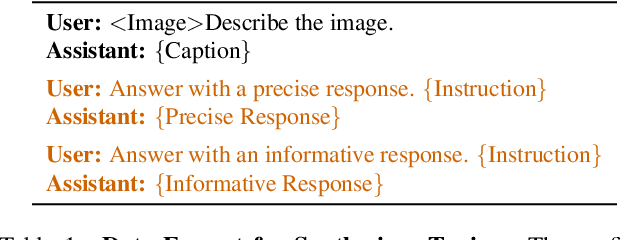
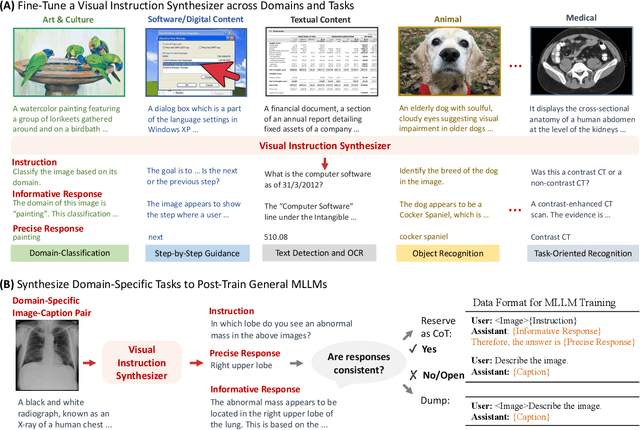

Abstract:Recent years have witnessed the rapid development of general multimodal large language models (MLLMs). However, adapting general MLLMs to specific domains, such as scientific fields and industrial applications, remains less explored. This paper systematically investigates domain adaptation of MLLMs through post-training, focusing on data synthesis, training pipelines, and task evaluation. (1) Data Synthesis: Using open-source models, we develop a visual instruction synthesizer that effectively generates diverse visual instruction tasks from domain-specific image-caption pairs. Our synthetic tasks surpass those generated by manual rules, GPT-4, and GPT-4V in enhancing the domain-specific performance of MLLMs. (2) Training Pipeline: While the two-stage training--initially on image-caption pairs followed by visual instruction tasks--is commonly adopted for developing general MLLMs, we apply a single-stage training pipeline to enhance task diversity for domain-specific post-training. (3) Task Evaluation: We conduct experiments in two domains, biomedicine and food, by post-training MLLMs of different sources and scales (e.g., Qwen2-VL-2B, LLaVA-v1.6-8B, Llama-3.2-11B), and then evaluating MLLM performance on various domain-specific tasks. To support further research in MLLM domain adaptation, we will open-source our implementations.
HabitAction: A Video Dataset for Human Habitual Behavior Recognition
Aug 24, 2024Abstract:Human Action Recognition (HAR) is a very crucial task in computer vision. It helps to carry out a series of downstream tasks, like understanding human behaviors. Due to the complexity of human behaviors, many highly valuable behaviors are not yet encompassed within the available datasets for HAR, e.g., human habitual behaviors (HHBs). HHBs hold significant importance for analyzing a person's personality, habits, and psychological changes. To solve these problems, in this work, we build a novel video dataset to demonstrate various HHBs. These behaviors in the proposed dataset are able to reflect internal mental states and specific emotions of the characters, e.g., crossing arms suggests to shield oneself from perceived threats. The dataset contains 30 categories of habitual behaviors including more than 300,000 frames and 6,899 action instances. Since these behaviors usually appear at small local parts of human action videos, it is difficult for existing action recognition methods to handle these local features. Therefore, we also propose a two-stream model using both human skeletons and RGB appearances. Experimental results demonstrate that our proposed method has much better performance in action recognition than the existing methods on the proposed dataset.
On the Emergence of Symmetrical Reality
Jan 26, 2024
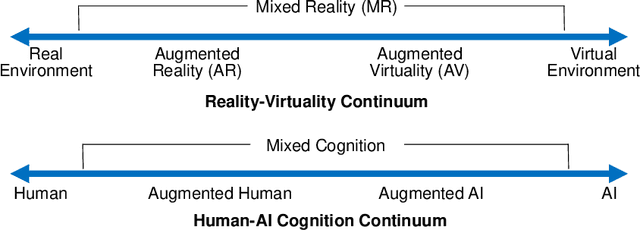
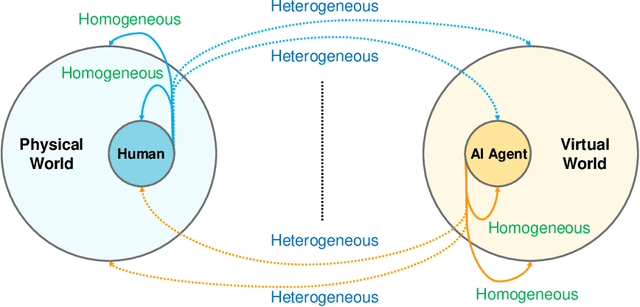
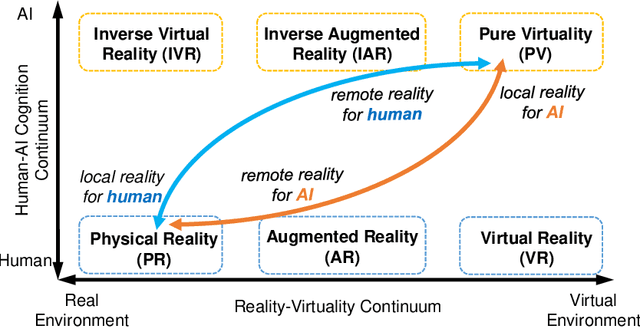
Abstract:Artificial intelligence (AI) has revolutionized human cognitive abilities and facilitated the development of new AI entities capable of interacting with humans in both physical and virtual environments. Despite the existence of virtual reality, mixed reality, and augmented reality for several years, integrating these technical fields remains a formidable challenge due to their disparate application directions. The advent of AI agents, capable of autonomous perception and action, further compounds this issue by exposing the limitations of traditional human-centered research approaches. It is imperative to establish a comprehensive framework that accommodates the dual perceptual centers of humans and AI agents in both physical and virtual worlds. In this paper, we introduce the symmetrical reality framework, which offers a unified representation encompassing various forms of physical-virtual amalgamations. This framework enables researchers to better comprehend how AI agents can collaborate with humans and how distinct technical pathways of physical-virtual integration can be consolidated from a broader perspective. We then delve into the coexistence of humans and AI, demonstrating a prototype system that exemplifies the operation of symmetrical reality systems for specific tasks, such as pouring water. Subsequently, we propose an instance of an AI-driven active assistance service that illustrates the potential applications of symmetrical reality. This paper aims to offer beneficial perspectives and guidance for researchers and practitioners in different fields, thus contributing to the ongoing research about human-AI coexistence in both physical and virtual environments.
 Add to Chrome
Add to Chrome Add to Firefox
Add to Firefox Add to Edge
Add to Edge